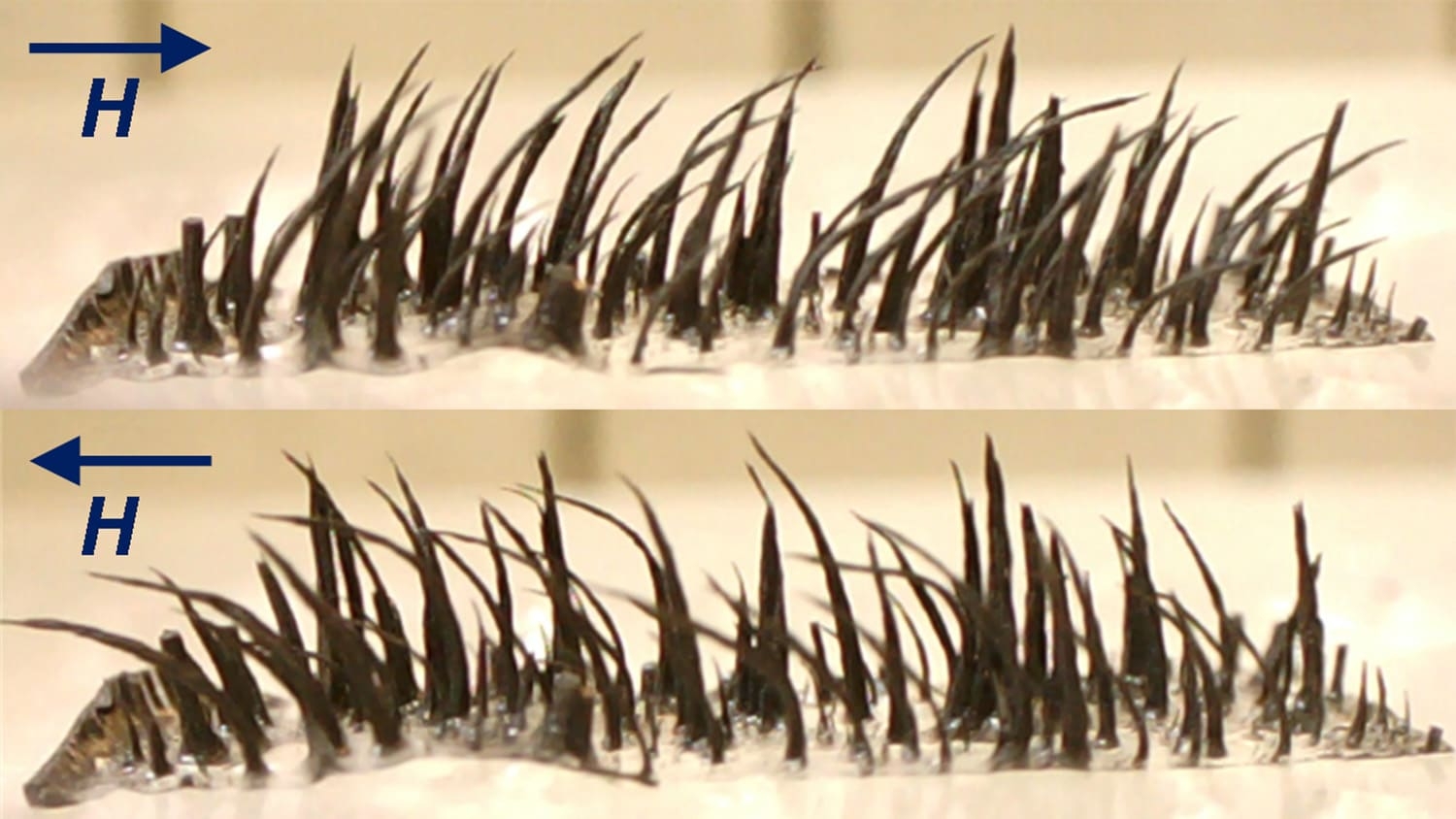Researchers have demonstrated the ability to grow high-quality thin films of a recently discovered superconductor material called potassium tantalate (KTaO3). The researchers also discovered that the material retains its superconductive characteristics even when exposed to extremely high magnetic fields.
A superconductor is a material that can carry electricity without any resistance – meaning none of the energy is dissipated as heat, for example. Superconductive materials hold promise for making a variety of more efficient technologies, such as faster computer components and more energy-efficient power devices. However, the field faces significant challenges. For example, many superconductive materials lose their superconductivity when exposed to magnetic fields, which limits their potential applications.
“Our work here is important because not only have we demonstrated how to fabricate high quality KTaO3, but we have also shown that the material is capable of withstanding substantial magnetic fields without losing its desirable properties,” says Kaveh Ahadi, corresponding author of three papers on the work and an assistant professor of materials science and engineering at North Carolina State University. “Specifically, we found that KTaO3 retains superconductivity even when exposed to magnetic fields up to 25 Tesla. This fundamental work is a necessary step toward the development of any potential applications for the material.”
The researchers were able to “grow” KTaO3 using a technique called molecular beam epitaxy, which effectively creates two-dimensional (2D) thin films of the material on a substrate by laying molecule-thin layers on top of one another with atomic-level precision. The resulting thin films have extremely high quality, meaning the molecular structure of the material has very few defects.
“These high-quality thin films are an ideal platform for studying the intrinsic properties of this materials system,” Ahadi says.
One such characterization study revealed that KTaO3 thin films remained superconductive when exposed to magnetic fields of up to 25 Tesla. To put that in context, the only place in the United States capable of generating a 25 Tesla magnetic field is the National High Magnetic Field Laboratory, which is where Ahadi and his collaborators tested the material.
“The research community is still in the early stages of understanding the superconductivity in KTaO3, much less identifying applications for the material,” Ahadi says. “Our work here not only identifies one attractive quality that sets it apart from other 2D superconductors, but provides a blueprint for how we can create KTaO3 thin films that are well suited for performing the research necessary to understand intrinsic properties of this materials system.”
The research is covered in three journal articles. Most recently, the paper “Enhanced Critical Field of Superconductivity at an Oxide Interface” was published July 27 in Nano Letters. Co-first authors of that paper are Athby Al-Tawhid, a postdoctoral researcher at NC State; and Samuel Poage, a Ph.D. student at NC State. The paper was co-authored by Divine Kumah, an associate professor of physics at NC State; Antonio Gonzalez, a Ph.D. student at NC State; Salva Salmani-Rezaie and David Muller of Cornell University; Shalinee Chikara of the National High Magnetic Field Laboratory; Maria Gastiasoro of the Donostia International Physics Center; and José Lorenzana of Sapienza University of Rome.
A second characterization article, “Anisotropic superconductivity at KTaO3(111) interfaces,” was published earlier this year in Science Advances. The journal article covering the ability to grow KTaO3 using molecular beam epitaxy, “Molecular beam epitaxy of KTaO3,” was published earlier this year in the Journal of Vacuum Science & Technology A.
The research behind these journal articles was done with support from the National Science Foundation, under grants 1751455, 2004870 and 2122147, as well as cooperative agreement 2039380; and from the Department of Energy, under grant DE-SC0002765.
-shipman-
Note to Editors: The study abstract follows.
“Enhanced Critical Field of Superconductivity at an Oxide Interface”
Authors: Athby H. Al-Tawhid, Samuel J. Poage, Antonio Gonzalez, Divine P. Kumah and Kaveh Ahadi, North Carolina State University; Salva Salmani-Rezaie and David A. Muller, Cornell University; Shalinee Chikara, National High Magnetic Field Laboratory; Maria N. Gastiasoro, Donostia International Physics Center; and José Lorenzana, Sapienza University of Rome
Published: July 27, Nano Letters
DOI: 10.1021/acs.nanolett.3c01571
Abstract: The nature of superconductivity and its interplay with strong spin-orbit coupling at the KTaO3(111) interfaces remains a subject of debate. To address this problem, we grew epitaxial LaMnO3/KTaO3(111) heterostructures. We show that superconductivity is robust against the inplane magnetic field, with the critical field of superconductivity reaching ~ 25 T in optimally doped heterostructures. The superconducting order parameter is highly sensitive to carrier density. We argue that spin-orbit coupling drives the formation of anomalous quasiparticles with vanishing magnetic moment, providing the condensate significant immunity against magnetic fields beyond the Pauli paramagnetic limit. These results offer design opportunities for superconductors with extreme resilience against magnetic field.
“Anisotropic superconductivity at KTaO3(111) interfaces”
Authors: Ethan G. Arnault and Gleb Finkelstein, Duke University; Athby H. Al-Tawhid, Divine P. Kumah and Kaveh Ahadi, North Carolina State University; Salva Salmani-Rezaie and David A. Muller, Cornell University; and Mohammad S. Bahramy, University of Manchester
Published: Feb. 15, Science Advances
DOI: 10.1126/sciadv.adf1414
Abstract: A two-dimensional, anisotropic superconductivity was recently found at the KTaO3(111) interfaces. The nature of the anisotropic superconducting transition remains a subject of debate. To investigate the origins of the observed behavior, we grew epitaxial KTaO3(111)-based heterostructures. We show that the superconductivity is robust against the in-plane magnetic field and violates the Pauli limit. We also show that the Cooper pairs are more resilient when the bias is along [112] (I ∥ [112]) and the magnetic field is along [110] (B ∥ [110]).We discuss the anisotropic nature of superconductivity in the context of electronic structure, orbital character, and spin texture at the KTaO3(111) interfaces. The results point to future opportunities to enhance superconducting transition temperatures and critical fields in crystalline, two-dimensional superconductors with strong spin-orbit coupling.
“Molecular beam epitaxy of KTaO3”
Authors: Tobias Schwaigert, Matthew R. Barone, Ethan Ray, Salva Salmani-Rezaie and David A. Muller, Cornell University; Hanjong Paik, Cornell University and the University of Oklahoma; Michael D. Williams, Clark Atlanta University; Darrell G. Schlom, Cornell University and Leibniz-Institut für Kristallzüchtung; and Kaveh Ahadi, North Carolina State University
Published: Feb. 2, Journal of Vacuum Science & Technology A
DOI: 10.1116/6.0002223
Abstract: Strain-engineering is a powerful means to tune the polar, structural, and electronic instabilities of incipient ferroelectrics. KTaO3 is near a polar instability and shows anisotropic superconductivity in electron-doped samples. Here, we demonstrate growth of high-quality KTaO3 thin films by molecular-beam epitaxy. Tantalum was provided by either a suboxide source emanating a TaO2 flux from Ta2O5 contained in a conventional effusion cell or an electron-beam-heated tantalum source. Excess potassium and a combination of ozone and oxygen (10% O3 + 90% O2) were simultaneously supplied with the TaO2 (or tantalum) molecular beams to grow the KTaO3 films. Laue fringes suggest that the films are smooth with an abrupt film/substrate interface. Cross-sectional scanning transmission electron microscopy does not show any extended defects and confirms that the films have an atomically abrupt interface with the substrate. Atomic force microscopy reveals atomic steps at the surface of the grown films. Reciprocal space mapping demonstrates that the films, when sufficiently thin, are coherently strained to the SrTiO3 (001) and GdScO3 (110) substrates.
This post was originally published in NC State News.
- Categories:



